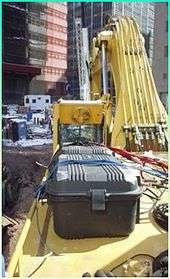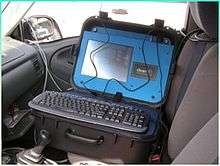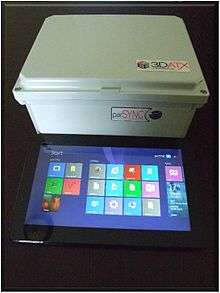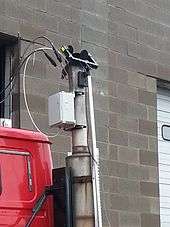Portable emissions measurement system

A portable emissions measurement system (PEMS) is essentially a lightweight ‘laboratory’ that is used to test and/or assess mobile source emissions (i.e. cars, trucks, buses, construction equipment, generators, trains, cranes, etc.) for the purposes of compliance, regulation, or decision-making. Early examples of vehicle emissions equipment were developed and marketed by Warren Spring Laboratory UK during the early 1990s. This equipment was used to measure on-road emissions as part of the UK Environment Research Programme. Governmental entities like United States Environmental Protection Agency (USEPA), European Union, as well as various states and private sector entities have begun to utilize PEMS in order to reduce both the costs and time involved in making mobile emissions decisions. Various state, federal, and international agencies began referring to this shorthand term in the early 2000s, and the nickname became part of industry parlance.
Background
Since the mid-19th century, dynamometers (or "dyno" for short) have been used to measure torque and rotational speed (measured in rpm) from which power produced by an engine, motor or other rotating prime mover can then be calculated. A chassis dynamometer measures power from the engine through the wheels. The vehicle is parked on rollers which the car then turns and the output is measured. These dynos can be fixed or portable. Because of frictional and mechanical losses in the various drivetrain components, the measured horsepower is generally 15–20 percent less than the brake horsepower measured at the crankshaft or flywheel on an engine dynamometer.[1] Historically though, dynamometer emission tests are very expensive, and have usually involved removing fleet vehicles from service for a long period of time. Also, the data derived from such testing is not representative of “real world” driving conditions, not least due to numerous and ample flexibilities in laboratory test procedures, particularly in the European Union's "New European Driving Dycle (NEDC)".[2] Beyond that, this test method cannot be deemed as representative, especially due to the relatively low amount of repeatable tests at such a facility.
Introduction of PEMS
Leo Breton of the USEPA questioned dynamometer testing's ability to reflected real-world emissions levels of vehicles on-road.[3] To investigate the matter, in 1995 he constructed a device called ROVER, short for Real-time On-road Vehicle Emissions Reporter.[4] The first commercially available device was invented and patented by Michal Vojtisek-Lom, in conjunction with Clean Air Technologies International (CATI) Inc. out of Buffalo, New York in 1999. The early commercially available units relied upon engine data from either an "On-Board Diagnostic" (OBD) port or directly from an engine sensor array. The first unit was developed for, and sold to - Dr. H. Christopher Frey of North Carolina State University NCSU) for the first ever on-road testing project sponsored by the North Carolina Department of Transportation. David W. Miller, who co-founded CATI, first coined the phrase "Portable Emissions Measurement System" and "PEMS" when working on a 2000

New York City Metropolitan Transportation Agency bus project with Dr. Thomas Lanni of the New York State Department of Environmental Conservation, as a short-hand description of the new device. Other governmental groups and universities soon followed, and quickly began to utilize the equipment due to its balance of accuracy, low cost, light weight, and availability. From 1999 through 2004, research groups such as Virginia Tech, Penn State, and Texas A&M Transportation Institute, Texas Southern University and others began to use PEMS in border crossing projects, roadway evaluations, traffic control methods, before-and-after scenarios, and even on ferries, planes, and off-road vehicles, to explore what was possible outside of a lab environment. A project performed in April 2002 by the California Air Resources Board(ARB) - utilizing non-1065 PEMS equipment, tested 40 trucks over a period of 2 ½ days; of which, 22 trucks were tested on road in Tulare, California. Also during this timeframe, one such high-profile project performed with early PEMS equipment was the World Trade Center (WTC) Ground Zero Project in lower Manhattan, testing concrete pumpers, bulldozers, graders, and later - diesel cranes on Building #7 - 40 stories high. Other early PEMS projects such as Dr. Chris Frey's field work was used by the USEPA in the development of the MOVES Model. However, users such as regulators and vehicle manufacturers had to wait for ROVER to be commercialized to conduct actual measurements of mass emissions rather than depend on estimates of mass emissions using data the OBD port, or a direct engine measurement, in order to have a more defensible data set. This push led to a new 2005 standard known as CFR 40 Part 1065.
Many governmental entities (such as the USEPA and the United Nations Framework Convention on Climate Change or UNFCCC) have identified target mobile-source pollutants in various mobile standards as CO2, NOx, Particulate Matter (PM), Carbon Monoxide (CO), Hydrocarbons(HC), to ensure that emissions standards are being met. Further, these governing bodies have begun adopting in-use testing program for non-road diesel engines, as well as other types of internal combustion engines, and are requiring the use of PEMS testing. It is important to delineate the various classifications of the latest ‘transferable’ emissions testing equipment from-time PEMS equipment, in order to best understand the desire of portability in field-testing of emissions.
Defining portability
An important step in the evaluation of a PEMS device is to define what a PEMS device is as well as to understand various classifications of ‘transferable vehicle testing equipment’:
Definition of the term “portable”
The word portable typically conveys an object that is “Carried or moved with ease, such as a light or small typewriter.”[5] The implication is that this is a special attribution for what would otherwise generally be non-portable objects. PEMS is in contrast with lab based systems that measure in circumstances other than normal use.

Definition of the Term “Mobile”
The definition of mobile is essentially “…capable of moving or of being moved readily from place to place: a mobile organism; a mobile missile system.” [6]
Definition of “Instrumented”
Instrumented means to be “a device for recording, measuring, or controlling, especially such a device functioning as part of a control system.”[7]
Therefore, the subtle difference between ‘portable’ and ‘mobile’ is that a portable system is a lightweight device able to be carried, whereas a mobile system can be readily moved, and ‘instrumented’ means that the testing equipment has been incorporated into the host system. These distinctions are critical, especially considering additional guidelines from various US and International standards.
Definition determined by the National Institute for Occupational Safety and Health (NIOSH)
The National Institute for Occupational Safety and Health (NIOSH) defines these terms based on an equation known as the “NIOSH Lifting Equation” (http://www.cdc.gov/niosh/docs/94-110/pdfs/94-110-b.pdf) and the “NIOSH Procedures for Analyzing Lifting Jobs (http://www.cdc.gov/niosh/docs/94-110/pdfs/94-110-c.pdf). These clearly outline safety procedures and equipment. (these are also specified in the “Occupational Safety Hazard Act 29 CFR parts 1903, 1904, and 1910) [8]
Safety Guidelines and Standards (the NIOSH lifting equation)
It is imperative to refer to existing federal standards and guidelines when determining a proper ergonomically safe and correct procedure. Not only is this important to ensure the safety of the worker(s), but also to ensure the reduction in potential future liability. Therefore, the revised NIOSH Lifting Equation is an excellent source of information to determine what a single worker should or shouldn’t perform.
Based upon the NIOSH lifting equation and assuming that this diagram is analogous to the lifting of a PEMS into the cab of a heavy-duty truck the upper threshold of the total weight of a PEMS device typically should not exceed 45 lb (20 kg)., in order to be congruent with national and international safety standards. This not only allows for much more safe maneuverability and ease of use, but it also reduces the amount of workers required to safely perform such tasks.
Economic advantage of PEMS equipment

Because a PEMS unit is able to be carried easily by one person from jobsite to jobsite, and can be used without the requirement of ‘team lifting’, the required emissions testing projects are economically viable. Simply put, more testing can be done more quickly, by less workers, dramatically increasing the amount of testing done in a certain time period. This in turn, significantly reduces the ‘cost per test’, yet at the same time increases the overall accuracy required in a ‘real-world’ environment.[9] Because the law of large numbers will create a convergence of results, it means that repeatability, predictability, and accuracy are enhanced, while simultaneously reducing the overall cost of the testing.
On-road emissions patterns identified by PEMS
Nearly all modern engines, when tested new and according to the accepted testing protocols in a laboratory, produce relatively low emissions well within the set standards. As all individual engines of the same series are supposed to be identical, only one or several engines of each series get tested. The tests have shown that:
- The bulk of the total emissions can come from relatively short high-emissions episodes
- Emissions characteristics can be different even among otherwise identical engines
- Emissions outside of the bounds of the laboratory test procedures are often higher than under the operating and ambient conditions comparable to those during laboratory testing
- Emissions deteriorate significantly over the useful life of the vehicles
- There are large variances among the deterioration rates, with the high emissions rates often attributable to various mechanical malfunctions
These findings are consistent with published literature, and with the data from a myriad of subsequent studies. They are more applicable to spark-ignition engines and considerably less to diesels, but with the regulation-driven advances in diesel engine technology (comparable to the advances in spark-ignition engines since the 1970s) it can be expected that these findings are likely to be applicable to the new generation diesel engines. Since 2000, multiple entities have utilized PEMS data to measured in-use, on-road emissions on hundreds of diesel engines installed in school buses, transit buses, delivery trucks, plow trucks, over-the-road trucks, pickups, vans, forklifts, excavators, generators, loaders, compressors, locomotives, passenger ferries, and other on-road, off-road and non-road applications. All the previously listed findings were demonstrated; in addition, it was noticed that extended idling of engines can have a significant impact on the emissions during subsequent operation.
Also, PEMS testing identified several engine “anomalies” where fuel-specific NOx emissions were two to three times higher than expected during some modes of operation, suggesting deliberate alterations of the engine control unit (ECU) settings. Such data set can be readily used for developing emissions inventories, as well as to evaluate various improvements in engines, fuels, exhaust after-treatment and other areas. (Data collected on “conventional” fleets then serves as “baseline” data to which various improvements are compared.) This data set can also be examined for compliance with not-to-exceed (NTE) and in-use emissions standards, which are ‘US-based’ emission standards that require on-road testing.
Accuracy of PEMS

The question often arises as to the target accuracy of PEMS. As PEMS are typically limited in size, weight and power consumption, it is often difficult for PEMS to offer the same accuracy and variety of species measured as is possible with top of the line laboratory instrumentation. For this reason, objections were raised against using PEMS for compliance verification.
On the other hand, fleet emissions deduced from laboratory measurements can be subject to significant inaccuracies if the selected engines and operating conditions were not representative of the fleet, or if deliberate anomalies (i.e., dual mapping of the ECU) were not demonstrated during laboratory testing.
The question of how accurate a monitoring system needs to be therefore cannot be objectively answered, neither can a monitoring system be easily designed, without first considering the intended application of the system and the errors associated with different approaches.
It is expected that a variety of on-board systems will be designed, ranging from suitcase-sized PEMS to instrumented trailers towed behind the tested truck. The benefits of each approach need to be considered in light of other sources of errors associated with emissions monitoring, notably vehicle-to-vehicle differences, and the emissions variability within the vehicle itself. In other words, one needs to consider the total of:
- The difference between what is measured and what is actually emitted during a test
- The difference between what is emitted during the test and what the vehicle emits during its everyday duties
- The difference between the emissions characteristics of the tested vehicle and the overall emissions levels of the entire fleet.
For example, when evaluating a benefit of cleaner fuels on a fleet of city buses, one needs to compare taking a bus out of service, installing a laboratory-grade monitoring system, loading it with sandbags and driving it on a simulated route against testing several buses on their regular routes, with passengers on board, using a simpler (and possibly less accurate) monitoring system.
Additional PEMS Criteria
Another important aspect that needs to be evaluated is the safety of using PEMS on public roadways. Extensions of the tailpipe, lines and cables extending far beyond the vehicle sides, lead-acid batteries located in the passenger compartment of a bus, sharp objects, hot components accessible to bystanders, equipment blocking emergency exits or interfering with the driver, loose components likely to be caught on moving parts, and other potential hazards need to be examined. Also, any modifications to or disassembly of the tested vehicle (i.e., drilling into the exhaust, removing intake air system) need to be examined for their acceptance by both fleet managers and drivers, especially on passenger-carrying vehicles. The source of power for PEMS is a concern, as only a limited amount of power can be extracted from the vehicle electrical system. Sealed lead-acid batteries, fuel cells and generators have been used as external power sources, each with a potential significant hazard when driven on the road.

A PEMS also has to be practical. Installation time and the expertise level required to perform installation and to operate the PEMS will have a significant impact on the cost of the test, and on the number of vehicles tested. Versatility (ability to test different vehicles) may be important if testing dissimilar engines or vehicles. Total size, weight and transportability of the PEMS needs to be considered when testing at different locations, including any consumables such as calibration gases. Any restrictions on transport of hazardous materials (i.e.Flame ionization detector (FID) fuel or calibration gases) need to be taken into the account. The ability of the test crew to repair PEMS in the field using locally available resources can also be essential when testing away from the base. Thus, PEMS evaluation protocol should be expanded. In addition to the laboratory comparison testing, which is a measure of how accurately PEMS measures when operated in a laboratory, the accuracy and repeatability of PEMS should also be examined on the road, possibly while driving along a well-defined, repeatable route, or while driving chassis dynamometer cycles on a test track.
PEMS suitability to application
Ultimately, it should be demonstrated to show that a PEMS is suitable to the desired application. If the ultimate goal is to verify the compliance with in-use emissions requirements, a fleet of vehicles with known characteristics – including engines with dual-mapping and otherwise non-compliant engines – should be made available for testing. It should be then up to the PEMS manufacturers to practically demonstrate how these non-compliant vehicles can be identified using their system.
Testing volume and safe repeatability
In order to achieve the required amount of ‘testing volume’ needed to validate real-world testing, three points must be considered:
- System accuracy
- Federal and/or state health and safety guidelines and/or standards
- Economic viability based on the first two points.
Once a particular portable emissions system has been identified and pronounced as accurate, the next step is to ensure that the worker(s) are properly protected from work hazards associated with the task(s) being performed in the use of the testing equipment. For example, typical functions for a worker may be to transport the equipment to the jobsite (i.e. car, truck, train, or plane), carry the equipment to the jobsite, and lift the equipment into position.
Advantages of PEMS

On-road vehicle emissions testing is very different from the laboratory testing, bringing both considerable benefits and challenges: As the testing can take place during the regular operation of the tested vehicles, a large number of vehicles can be tested within a relatively short period of time and at relatively low cost. Engines than cannot be easily tested otherwise (i.e., ferry boat propulsion engines) can be tested. True real-world emissions data can be obtained. The instruments have to be small, lightweight, withstand difficult environment, and must not pose a safety hazard. Emissions data is subject to considerable variances, as real-world conditions are often neither well defined nor repeatable, and significant variances in emissions can exist even among otherwise identical engines. On-road emissions testing therefore requires a different mindset than the traditional approach of testing in the laboratory and using models to predict real-world performance. In the absence of established methods, use of PEMS requires careful, thoughtful, broad approach. This should be considered when designing, evaluating and selecting PEMS for the desired application.
A recent example of PEMS advantages over laboratory testing is the Volkswagen (VW) Scandal of 2015. Under a small grant from the International Council for Clean Transportation Dan Carder and Arvind Thiruvengadam of West Virginia University (WVU) uncovered on-board software "cheats" that VW had installed on some diesel passenger vehicles. The only way the discovery could have been made was by a non-programmed, random, on-road evaluation - utilizing a PEMS device. VW is now liable for over 14 billion USD in fines. In 2016, these latest developments led to a global resurgence of interest in smaller, lighter, and cost-effective "non-1065" PEMS, similar to the demonstration on the Mythbusters 2011 Premiere Episode of "Bikes and Bazookas", in which a non-1065 PEMS was used to establish the difference between car and motorcycle pollution.
See also
- https://patents.google.com/patent/US6148656A/en
- http://www.google.com/patents/US6308130
- https://www.google.com/patents/US6435019?dq=ininventor:%22Michal+Vojtisek-Lom%22&hl=en&sa=X&ved=0ahUKEwiq5vbfr-fOAhVIkx4KHWsTDxUQ6AEILDAC
- https://www.google.com/patents/WO2016044730A1?cl=en&dq=US2015/050950
- http://patft.uspto.gov/netacgi/nph-Parser?Sect1=PTO1&Sect2=HITOFF&d=PALL&p=1&u=%2Fnetahtml%2FPTO%2Fsrchnum.htm&r=1&f=G&l=50&s1=90,86,342.PN.&OS=PN/90,86,342&RS=PN/90,86,342
- https://www.linkedin.com/groups/3790500
- Automobile emissions control
- National Ambient Air Quality Standards (USA EPA)
References
- ↑ John Dinkel, "Chassis Dynamometer", Road and Track Illustrated Automotive Dictionary, (Bentley Publishers, 2000) p. 46.
- ↑ "Explaining road transport emissions - A non-technical guide, pages 27 to 37. — European Environment Agency". www.eea.europa.eu. Retrieved 2016-03-01.
- ↑ Johson, Dennis (2002-02-13). "ROVER - Real-time On-road Vehicle Emissions Reporter Dennis Johnson, US EPA" (PDF). Real-time On-road Vehicle Emissions Reporter Dennis Johnson, US EPA. US EPA. Retrieved 2016-03-01.
- ↑ "Real-time on-road vehicle exhaust gas modular flowmeter and emissions reporting system". patents.google.com. 1999-01-05. Retrieved 2016-03-01 Breton used this device to pioneer the field or real-world testing while simultaneously developing it into a system for commercialization by the manufacturers of conventional laboratory equipment. Breton used OBD port data for diagnostic purposes but believed it was not reliable enough for true mass measurements. There was also the potential that vehicle manufacturers would manipulate the OBD data once it was known to be part of the emissions calculation.. Check date values in:
|access-date=(help) - ↑ The American Heritage Dictionary of the English Language (http://www.thefreedictionary.com/portable Dictionary definition)
- ↑ The American Heritage Dictionary of the English Language (http://www.thefreedictionary.com/mobile Dictionary definition)
- ↑ The American Heritage Dictionary of the English Language (http://www.thefreedictionary.com/instrument Dictionary definition)
- ↑ Occupational Safety and Health Administration Occupational Safety Hazard Act 29
- ↑ El-Shawarby I., Ahn K., and Rakha H. (2005), Comparative Field Evaluation of Vehicle Cruise Speed and Acceleration Level Impacts on Hot Stabilized Emissions. Transportation Research Part D, 10 (1), pp 13–30.
External links
- Example of a request for grant application by Texas Commission on Environmental Quality for a project that required the use of a PEMS
- A study of snowmobile emissions by University of Denver uses PEMS to detect emissions Winter Motor-Vehicle Emissions in Yellowstone National Park
- M. J. Bradley & Associates, Inc. monitored emissions from off-road vehicles at the World Trade center reconstruction site Investigation of Diesel Emission Control Technologies on Off-Road Construction Equipment at the World Trade Center and PATH Re-Development Site
- Report Prepared by North Carolina State University for the USEPA with recommendations for the next generation of PEMS devices to be developed Recommended Strategy For On-Board Emission Data Analysis and Collection For the New Generation Model
- A Biodiesel study for the North Carolina Department of Transportation performed by North Carolina State University uses a PEMS device to gather emissions comparison data Operational Evaluation of Emissions and Fuel Use of B20 Versus Diesel Fueled Dump Trucks
- An Environmental Protection Agency information page on PEMS Science for the 21st Century
- Examples of PEMS companies: 3DATX Corporation,AVL, Horiba, Sensors, Inc.
- Example of an open user PEMS Group: LinkedIn PEMS Group
- The Imperial College London (UK) Centre for Transport Studies conducted a vehicle performance study and gathered emissions data along the M42 Motorway using a PEMS device Instantaneous Vehicle Emission Monitoring
- Recent uses and presentations of PEMS: University of California (UCR) College of Engineering - Center for Environmental Research and Technology (CE-CERT)